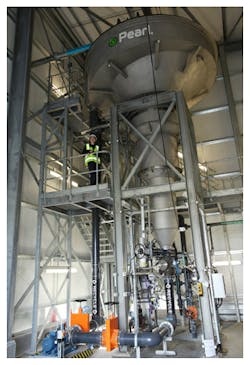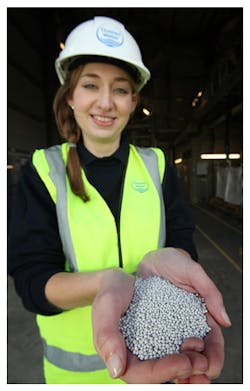Crystal Green fertilizer pellets (Photo credit: Thames River)
|
While the source for the fertilizer produced by the new facility may be dirty, the product itself -- Crystal Green -- is extremely clean. Likewise, heavy metals content, in particular, is very low by an order of magnitude in the product.
With the new facility up and running, Thames Water expects to save up to £200,000 ($321,000) per year, which it has until now spent on chemical dosing to clear pipes of struvite at Slough. All such operational savings put a downward pressure on customers' bills.
The new reactor will also improve the quality of treated effluent leaving the sewage works, reducing nutrient levels and in turn reducing algae growth in rivers and streams, which can suck oxygen out of watercourses, leaving little for fish and other wildlife. The reactor is expected to sustainably produce 150 tons per year (a half a ton per day) of top-grade fertilizer for sale to crop-growers, golf green-keepers and gardeners.
All of the UK's imported fertilizer is "water-soluble" and so is less crop-efficient and poses a higher environmental risk due to it leaching into waterways, causing surges in algal growth. The Crystal Green fertilizer being produced at Slough avoids these problems: as well as coming from a sustainable source, it is slow-released and much more efficient for plants and kinder to the environment.
*Peak phosphorus (Source: Soil Association):
Worldwide, 158 million tons of phosphate rock is mined every year, but the supply is finite. Recent analysis suggests that we may hit ‘peak’ phosphate as early as 2033, after which supplies will become increasingly scarce and more expensive. This critical issue is missing from the global policy agenda. Without fertilization from phosphorus, it has been estimated that wheat yields could more than halve in coming decades, falling from nine tons.
###




